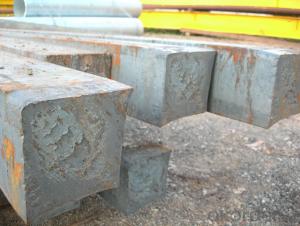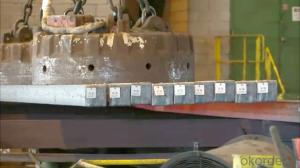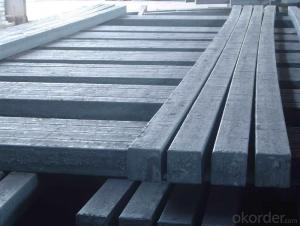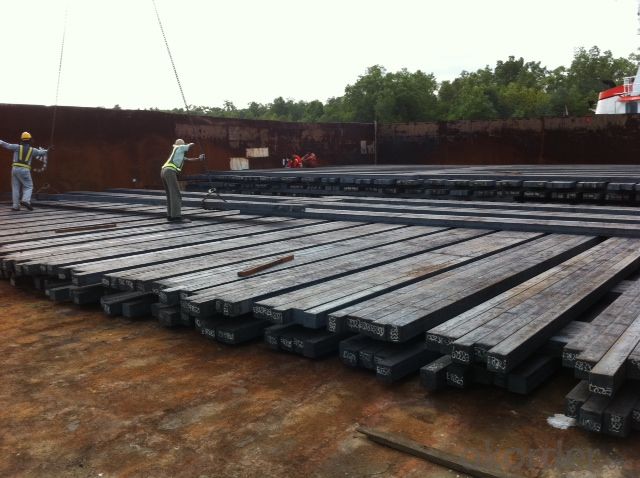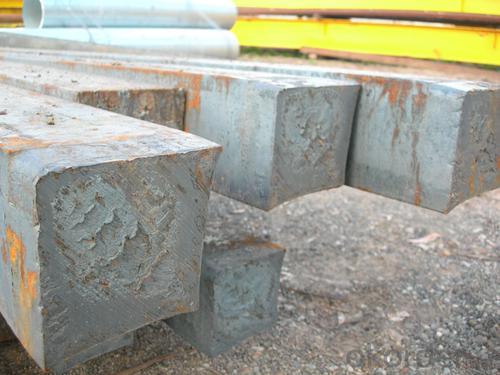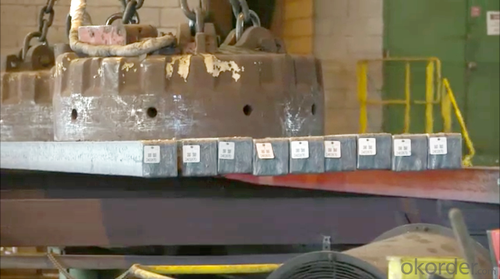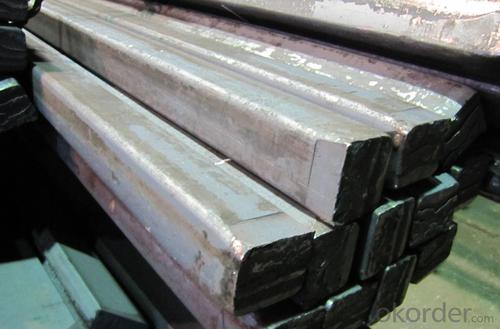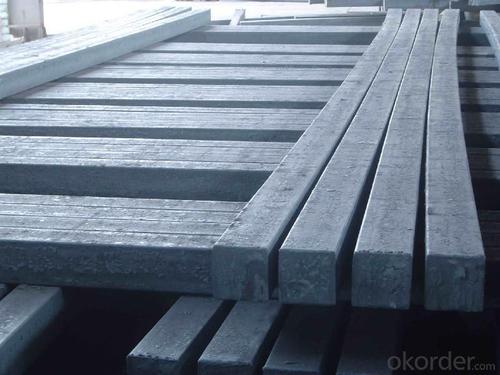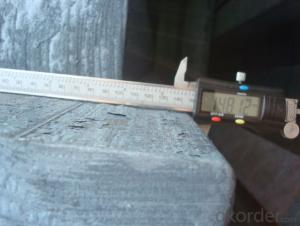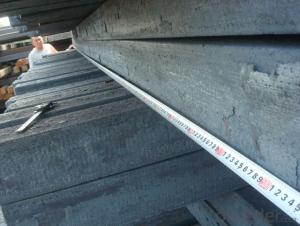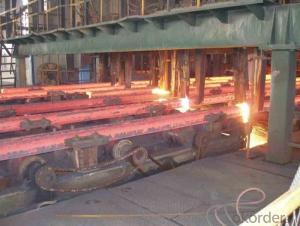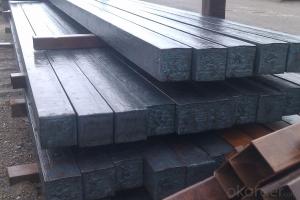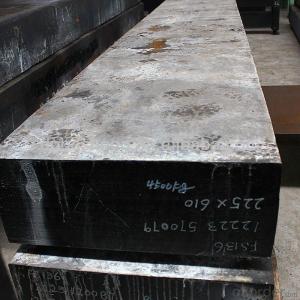Prime square alloy steel billet 165mm Q235
- Loading Port:
- Shanghai
- Payment Terms:
- TT OR LC
- Min Order Qty:
- 100 m.t.
- Supply Capability:
- 10000 m.t./month
OKorder Service Pledge
OKorder Financial Service
You Might Also Like
Structure of Prime square alloy steel billet 165mm Q235

Description of Prime square alloy steel billet 165mm Q235
1) Excellent corrosion resistance: The zinc layer provides a good protection of Pre-painted Galvanizeed Steel Sheet.
2) High heat resistance: The reflective surface of the material aids in efficiently reflecting the sunlight away and in turn reducing the amount of heat transmitted. The thermal reflectivity converts into energy savings.
3) Aesthetics: Pre-Painted Galvanized steel sheet is available in plethora of patterns and multiple sizes as per the requirements that given by our customers.
4) Versatility: can be used in the various areas.

Main Feature of Prime square alloy steel billet 165mm Q235
Uncoated CR steel sheet
With the features of in line with the international highest standards in demension and shape, excellent surface finish and properties, the products are mainly used in home appliance and automobile industries.
Galvanized steel sheet(include HDG and EG)
With the features of good corrosion resistance, the products are mainly used in automobile, home appliance, electronics, building and machinery manufacture industries, etc.
Precoated steel sheet
With the features of enviromental protection and good processablility, long lasting surface durability, rich in colors, the products are maily used in building, home appliance and furniture industries, etc.
Applications of Prime square alloy steel billet 165mm Q235
1) Excellent corrosion resistance: The zinc layer provides a good protection of Pre-painted Galvanizeed Steel Sheet.
2) High heat resistance: The reflective surface of the material aids in efficiently reflecting the sunlight away and in turn reducing the amount of heat transmitted. The thermal reflectivity converts into energy savings.
3) Aesthetics: Pre-Painted Galvanized steel sheet is available in plethora of patterns and multiple sizes as per the requirements that given by our customers.
4) Versatility: can be used in the various areas.

Specifications of Prime square alloy steel billet 165mm Q235
Product | Billet |
Material Grade | SGCC / SGCH / DX51D+AZ, etc |
Thickness | 0.6-3.0mm |
Width | 500-1500mm |
Tolerance | Thickness: +/-0.02mm , Width:+/-2mm |
Zinc-coating | Z30-150g/m2 |
Technique | Raw material: Hot rolled steel coil --> Cold rolled_>hot dipped galvalume |
Surface | Dried, Chromated, Unoiled |
Spangle | Regular spangle , small spangle, zero spangle |
ID | 508MM 610MM |
Coil weight | 1-25MT |
Export package | Cardboard inner sleeves, Waterproof paper, galvanized steel covered and steel strip packed |
FAQ of Prime square alloy steel billet 165mm Q235
We have organized several common questions for our clients,may help you sincerely:
1. How Can I Visit There?
Our company is located in Tianjin City, China, near Beijing. You can fly to Tianjin Airport Directly. All our clients, from home or aboard, are warmly welcome to visit us!
2. How Can I Get Some Sample?
We are honored to offer you sample.
3. Why choose CNBM?
we always fix steel produce in container well to make it safe arrive at destination port
we always provide best and professional forward service for our buyer
we always apply 14days free detention for our buyers container in destination
we provide one set After-sales service for our buyer
we provide China inland steel market price report
we help our buyer become number one in local market .
- Q: Billet heating furnace billet temperature reached, steel will be adhesion
- As soon as the melting point is reached, the part melts before sticking. But heating will swell a lot, you need to leave enough space.
- Q: How do steel billets contribute to the overall sustainability of a structure?
- Steel billets play a crucial role in enhancing the overall sustainability of a structure in several ways. Firstly, steel is a highly durable material that has a long lifespan, meaning structures built with steel billets will have a longer service life and require fewer replacements or repairs. This reduces the consumption of resources and materials needed for construction, thereby minimizing waste and conserving energy. Additionally, steel is 100% recyclable, which means that at the end of a structure's lifespan, the steel billets can be easily recovered and reused for other purposes. Recycling steel requires significantly less energy compared to producing it from raw materials, resulting in reduced greenhouse gas emissions and lower carbon footprints. This circular economy approach helps to conserve resources and reduce the demand for new steel production, which has a significant environmental impact. Furthermore, steel billets contribute to the overall sustainability of a structure through their strength and versatility. Steel has a high strength-to-weight ratio, meaning it can support heavy loads with less material, resulting in more efficient designs and reduced material consumption. This not only conserves resources but also reduces the carbon emissions associated with the transportation and delivery of steel. Moreover, steel is a non-combustible material, making structures built with steel billets less susceptible to fires. This enhances the safety and resilience of the structure, reducing the risk of damage or collapse during unforeseen events. The use of steel in structures can also contribute to energy efficiency by providing a thermal mass that retains and releases heat, reducing the need for excessive heating or cooling. In summary, steel billets contribute to the overall sustainability of a structure through their durability, recyclability, strength, and non-combustible properties. By using steel in construction, we can minimize waste, conserve resources, reduce carbon emissions, enhance safety, and improve energy efficiency, making structures more environmentally friendly and sustainable in the long run.
- Q: How are steel billets sheared into smaller sections?
- Using a mechanical technique called shearing, steel billets are cut into smaller sections. This procedure involves the utilization of a shearing machine equipped with a specific sharp blade or blades designed for cutting through the steel billet. Firstly, the steel billet is placed on a sturdy cutting table, and then the shearing machine is activated. With considerable force, the blade(s) of the machine are brought down onto the steel billet, effectively slicing through the material and separating it into smaller sections. Depending on the shearing machine's particular design, the blade(s) may move vertically, horizontally, or in a combination of both. To ensure a clean and precise cut, it is common practice to securely clamp the steel billet in place before commencing the shearing process. This precaution minimizes any potential movement or shifting of the material during cutting, which could lead to an uneven or inaccurate cut. Additionally, the blade(s) of the shearing machine are usually made from high-speed steel or another durable and sharp material to ensure efficient cutting and prolonged use. In conclusion, the shearing process is a highly efficient and effective method for dividing steel billets into smaller sections. It enables precise control over size and shape, making it an invaluable technique in numerous industries that utilize steel products.
- Q: How do steel billets contribute to the manufacturing of furniture?
- The manufacturing of furniture relies heavily on steel billets, which serve as the essential raw material needed to create strong and durable frames. These billets, produced through casting or hot rolling, are semi-finished steel products with a rectangular shape. After obtaining the steel billets, they can undergo various manufacturing techniques such as forging, extrusion, or machining to shape them into different furniture components. These components include frames for chairs, tables, beds, and other elements that require stability and strength. Using steel billets in furniture manufacturing offers several advantages. Firstly, steel is renowned for its exceptional strength and durability, making it an ideal material for furniture that can handle heavy loads and regular use. By utilizing steel billets, the furniture becomes robust and long-lasting, reducing the need for frequent replacements. In addition, steel billets provide design flexibility as they can be easily molded and shaped into different forms. This allows furniture manufacturers to create intricate and unique designs that meet customers' aesthetic preferences. Moreover, steel billets can be seamlessly welded, resulting in a more cohesive and visually appealing final product. Furthermore, steel is highly resistant to corrosion, which is crucial for furniture that may be exposed to moisture or environmental factors. By incorporating steel billets, the furniture remains free from corrosion, preserving its appearance and structural integrity over time. In conclusion, steel billets are indispensable in furniture manufacturing as they provide the necessary strength, durability, and flexibility to create sturdy frames and structural components. Their utilization enables furniture manufacturers to produce high-quality products that are long-lasting, visually appealing, and resistant to corrosion.
- Q: How do steel billets differ from steel bars?
- Steel billets and steel bars are both forms of semi-finished steel products, but they differ in terms of their size, shape, and production process. Steel billets are typically square or rectangular in shape and have a larger cross-sectional area compared to steel bars. They are produced through a casting process, where liquid steel is poured into molds and then allowed to solidify. On the other hand, steel bars are long, cylindrical shapes that are formed by rolling billets through a series of rolling mills. The rolling process increases the length and reduces the cross-sectional area of the steel, resulting in a more uniform shape and size.
- Q: What is the role of steel billets in the manufacturing of cutting tools?
- Steel billets play a crucial role in the manufacturing of cutting tools. They serve as the raw material from which the cutting tool is forged or machined. Steel billets are typically made from high-quality steel alloys, which possess properties like hardness, toughness, and wear resistance that are essential for cutting tools. The first step in the manufacturing process involves heating the steel billets to a specific temperature, known as the forging temperature. This temperature allows the steel to become malleable, making it easier to shape and form into the desired cutting tool. The heated billets are then subjected to a forging process, where they are struck or pressed using specialized equipment to shape them into the desired form, such as drills, saws, or blades. After the initial forging, the billets are further machined to refine their shape and dimensions. Machining processes like milling, turning, and grinding are used to remove excess material, achieve the precise dimensions required for the cutting tool, and create the desired cutting edge geometry. The quality of the steel billets used in the manufacturing process greatly influences the performance and durability of the cutting tool. Steel billets with high carbon content and alloying elements like chromium, vanadium, or tungsten are often preferred, as they enhance the hardness, strength, and wear resistance of the cutting tool. These properties are crucial for ensuring that the cutting tool can withstand the high forces, temperatures, and abrasive conditions it will encounter during use. In summary, steel billets are the starting point for manufacturing cutting tools. They provide the necessary raw material and properties required to create high-quality cutting tools that exhibit excellent performance, durability, and precision.
- Q: What are the main factors that influence the strength of steel billets?
- The strength of steel billets is impacted by various factors, including the chemical composition, heat treatment, and microstructure of the steel. The chemical composition plays a significant role in determining the strength of steel billets. Alloying elements like carbon, manganese, silicon, and chromium can enhance strength by forming solid solutions or precipitates that increase hardness and tensile strength. It is crucial to control impurity levels and maintain the desired balance of alloying elements to achieve the desired strength properties. Heat treatment is another important factor that affects the strength of steel billets. This process involves heating the steel to a specific temperature and then cooling it at a controlled rate. It significantly impacts the microstructure of the steel, which ultimately influences its strength. For example, quenching and tempering can result in the formation of desired microstructures like martensite or bainite, which enhance strength and toughness. The microstructure of steel billets also plays a crucial role in determining their strength. The arrangement of crystal grains and the presence of different phases within the steel greatly influence its mechanical properties. Fine-grained structures generally exhibit higher strength due to a greater number of grain boundaries, which inhibit dislocation movement and enhance strength. Additionally, the presence of specific microstructural features like precipitates or second-phase particles can contribute to the strength of steel billets. Other factors such as the manufacturing process, cooling rate during solidification, and mechanical working (such as rolling or extrusion) can also affect the strength of steel billets. These factors impact grain size, grain boundary density, and defect concentration, all of which influence the mechanical properties of the steel. In conclusion, the strength of steel billets is influenced by the chemical composition, heat treatment, and microstructure of the steel. These factors can be carefully controlled and optimized to achieve the desired strength properties for various applications.
- Q: What are the different methods of corrosion protection for steel billets?
- There are various methods available for corrosion protection of steel billets. Some of the common methods include: 1. Coating: Applying a protective coating on the surface of steel billets is one of the most effective methods of corrosion protection. This can be achieved through processes such as hot-dip galvanizing, painting, or applying a protective film. The coating acts as a barrier between the steel surface and corrosive elements in the environment, preventing direct contact and reducing the likelihood of corrosion. 2. Cathodic Protection: This method involves creating an electrochemical reaction to protect the steel billets from corrosion. Cathodic protection can be achieved by either using sacrificial anodes or by applying an impressed current. Sacrificial anodes, typically made of zinc or magnesium, are connected to the steel billets, and they corrode sacrificially instead of the steel, thus protecting it. Impressed current systems use an external power source to provide the necessary current to protect the steel. 3. VCI (Volatile Corrosion Inhibitors): VCI is a method that involves using chemicals that release vapors to create a protective layer on the steel surface. These chemicals inhibit the corrosion process by neutralizing the corrosive agents or forming a protective film on the steel surface. VCI can be applied through various methods, such as coating, wrapping, or inserting VCI paper or packets into the packaging of steel billets. 4. Alloying: Introducing alloying elements into the composition of steel billets can significantly improve their corrosion resistance. For example, adding chromium or nickel can enhance the stainless properties of steel, making it more resistant to corrosion. Alloying can be done during the initial production of steel billets or through post-treatment processes. 5. Environmental Control: Controlling the environment in which steel billets are stored or used is also crucial in preventing corrosion. This includes measures such as maintaining proper humidity levels, avoiding exposure to corrosive chemicals or gases, and minimizing contact with water or moisture. By controlling the environment, the likelihood of corrosion can be reduced, thereby protecting the steel billets. It is important to note that the choice of corrosion protection method depends on various factors, including the anticipated level of exposure to corrosive elements, the intended use of the steel billets, and cost considerations. Therefore, it is advisable to consult with corrosion experts or engineers to select the most suitable method for a particular application.
- Q: How are steel billets used in the production of industrial furnaces?
- Steel billets serve as a vital element in the manufacturing of industrial furnaces, being a key component required for the production of different furnace parts. To start off, the furnace shell or casing, which is responsible for providing structural integrity and containment, is fabricated using steel billets. These billets are shaped and welded together, forming a robust outer shell capable of enduring the high temperatures and harsh conditions inside the furnace. Additionally, steel billets are utilized in the creation of furnace doors and access panels. These components need to possess strength and resistance to deformation caused by the intense heat generated within the furnace. By employing steel billets, manufacturers can ensure that the doors and access panels are easily operable while maintaining their structural integrity over time. Furthermore, steel billets are also employed in the construction of furnace grates and supports. These components play a crucial role in holding and supporting the materials undergoing heating inside the furnace. By utilizing steel billets, manufacturers are able to fabricate sturdy and heat-resistant supports capable of withstanding heavy loads and high temperatures for extended periods. Moreover, steel billets are frequently employed in the fabrication of heat exchangers within industrial furnaces. Heat exchangers are vital for transferring heat from the combustion chamber to the materials being processed. The use of steel billets ensures that the heat exchangers possess exceptional thermal conductivity and can endure the corrosive effects of the furnace environment. Overall, steel billets have a critical function in the production of industrial furnaces, providing the necessary strength, durability, and resistance to heat required for the various components. Without steel billets, the manufacturing of furnaces capable of withstanding the extreme conditions encountered in industrial processes would be quite challenging.
- Q: How many tons of billets does it take to produce a ton of thread steel?
- The yield was increased, consumption will be reduced.
Send your message to us
Prime square alloy steel billet 165mm Q235
- Loading Port:
- Shanghai
- Payment Terms:
- TT OR LC
- Min Order Qty:
- 100 m.t.
- Supply Capability:
- 10000 m.t./month
OKorder Service Pledge
OKorder Financial Service
Similar products
Hot products
Hot Searches
Related keywords

